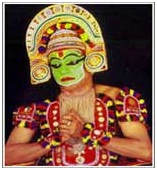Context
During the harvest festival in August-September, the artists prepareto leave home for long spells to perform at temple festivals across Kerala and perform song-and-dance Thullal, which is steeped in a satire on contemporary society through the themes are mythological.
About theThullal dance
- The word 'Thullal' means 'to leap or jump about playfully.
- It emerged in the eighteenth century.
- Three forms of thullal are - OttanThullal, ParayanThullal and SeethankanThullal. Of the three OttanThullal is the most popular.
Key features of the dance form
- A solo performance combines both dance and recitation.
- The performer through the classical acting techniques portrays the various characters in an episode and does the narration.
- Thullal is the explication of a tale which is drawn from the puranas and narrated in verse.
- It was introduced by KunchanNambiar, the renowned poet of the eighteenth century.
- The humorous and satiric mode of presentation and use of simple Malayalam language made thullal very popular among the ordinary people.
- It is accompanied by an orchestra of mridangam, harmonium and cymbals.
- The make-up is simple and very much similar to that of Kathakali.
- The face is painted with yellow arsenic mixed with blue color. The eyes are blackened and lips reddened.
- The dancer wears breast-plate which has golden pearls, necklaces and colourful tassels.
- The white waist clothes resemble the skirts.
- The head-gear is small which is made of light wood and studded with bright stones and decorated with golden paper.
- The bracelets, amulets and waistlets are almost similar as in Kathakali.

Art forms of kerala
- Kathakali, Ottamthullal, Chakyarkoothu,Krishnanattam,Koodiyattam,Padayani, Kalaripayattu, Pavakathakali, Theyyam, Velakali, Thiruvathirakali, Kolkali.
|
